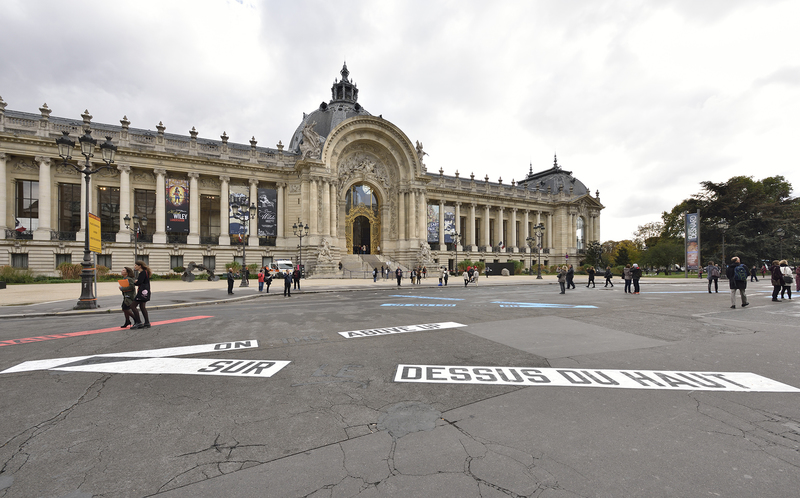FIAC 2016: onwards and upwards
Once again, the stately dome of the Grand Palais welcomed an art fair whose constantly growing dynamism relies entirely on its capacity for change and experimentation. Outside of and within the vast exhibition space, the programme ‘Parades for FIAC’ shook the French capital with a series of contemporary art performances, rarely seen by the general public and often forgotten in terms of art market value. Furthermore, this year saw the use of the Petit Palais next door as a site for a series of sculptures and installations, extending the selection of on-site interventions in the Jardin des Tuileries.
 View of Lawrence Weiner’s latest installation in front of Petit Palais. Copyright: Lawrence Weiner. Courtesy: the artist and Marian Goodman Gallery. Images: Rebecca Fanuele
View of Lawrence Weiner’s latest installation in front of Petit Palais. Copyright: Lawrence Weiner. Courtesy: the artist and Marian Goodman Gallery. Images: Rebecca Fanuele
While elements were added, others were removed, such as the OFFicielle satellite fair devoted entirely to young galleries. However, FIAC did not seem to suffer from the decision, on the contrary: the decision to expand the Grand Palais selection to 192 galleries and including a smaller selection of young galleries on the first floor, in fact, allowed for more focus and enjoyment of new gallery practices. Downstairs had the bustling crowds attracted towards the showmanship and appeal of established galleries, but upstairs had a solid and focused presentation which was given its time and space to shine. A few standout examples include Arcade Gallery’s refreshingly restrained display of Caroline Achaintre’s textile and compelling ceramic works, Rosa Barba’s arresting kinetic art installation at the Parra & Romero booth using the materiality of film and print letters, as well as museum quality work by the Peruvian artist Andrade Tuleda at Francesca Minini, using carbon for his sculptures and inkjet print effects on mirrors to create a strong juxtaposition of vertical forms.
 Caroline Achaintre, Hmmpf, 2016. Image credit: courtesy of Arcade, London.
Caroline Achaintre, Hmmpf, 2016. Image credit: courtesy of Arcade, London.
The young section had a good balance of overseas, European and French galleries. Meessen de Clerq’s gallery booth from Brussels showcased mysterious and playful inkjet print works by Nicolas Lamas, while Eastern Europe was well represented by Raster, based in Warsaw, and Plan B (Cluj/Berlin) showing a strong selection of works with a particular focus on high-quality figurative painting. The plywood works by Julian Hoeber from Jessica Silverman gallery (San Francisco) were particularly arresting, together with some historical works by feminist artist Judy Chicago. The Parisian gallery Semiose had a powerful solo booth of works by William S. Burroughs, the great writer and painter whose estate they represent; meanwhile, their neighbouring gallery Martine Aboucaya, also based in the Marais, presented a powerful video installation work by Michael Snow in an atmospheric, immaterial “black box” cinema space, as well as some miniature-like works by Claire Morel, reproducing the covers of significant books from the artist’s own library.
 Semiose’s booth with works by William S. Burroughs.
Semiose’s booth with works by William S. Burroughs.
The established international galleries had their share of spectacular booths. Neugerriemschneider from Berlin put together a show-stopping selection of works from Olafur Eliasson, Ai Weiwei and Rirkrit Tiravanija, while Sadie Coles allowed Urs Fisher to curate the booth with his own works and a sensitive inclusion of a Sarah Lucas work with neon tights. Meanwhile, Blum & Poe’s booth became a shrine-like space devoted entirely to Yoshitomo Nara’s ceramic sculptures and sketches. There was perhaps less experimentation and more of a safe selection in this part of the fair, but never accompanied by any compromise on quality and display.
 Installation view of work by Urs Fischer and Sarah Lucas at Sadie Coles HQ’s booth at FIAC, 2016. Copyright the artist, courtesy of Sadie Coles HQ, London. Photo: Andrea Rossetti
Installation view of work by Urs Fischer and Sarah Lucas at Sadie Coles HQ’s booth at FIAC, 2016. Copyright the artist, courtesy of Sadie Coles HQ, London. Photo: Andrea Rossetti
Galleries were unanimous in their views about sales and client visits: they were hurt by both American collectors’ fears in visiting Paris still recovering from its terrorist attacks, and by the unusually long delay this year between Frieze and Fiac. However, the mood was still optimistic, helped by the great quality of the works on display, which once again surpassed Frieze London and reinforced Fiac’s position as one of the most prestigious art fairs in the world, possibly only second to Art Basel.
Claire, artvisor
Claire holds a degree in art history from Oxford University and master’s degree in Curating from the Courtauld Institute of Art. She is a French and British national and has worked in museums and art institutions in both countries.
Content retrieved from: https://www.artvisor.com/journal/99162322-5b12-4f27-a521-d8073eaccc3d.

